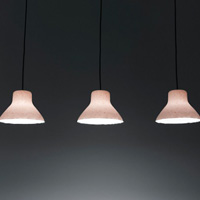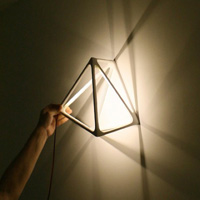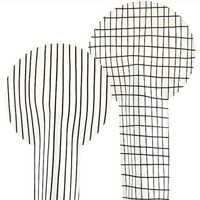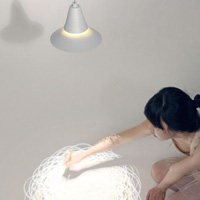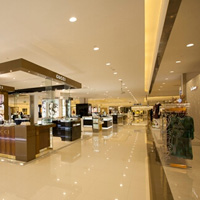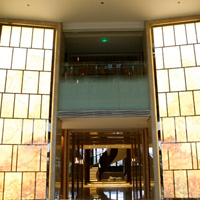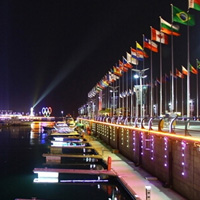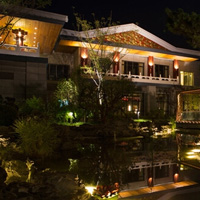Paulina Villalobos: 灯光设计理念先行
摘要: Paulina Villalobos在位于智利北部的阿卡塔马沙漠长大,这是世界上最干燥的地方,接受着异常强烈的太阳辐射,同时也拥有便于天文观测的清澈天空……也许这都是Paulina迷恋上“光”的伏笔。
个人简介
Paulina Villalobos在位于智利北部的阿卡塔马沙漠长大,这是世界上最干燥的地方,接受着异常强烈的太阳辐射,同时也拥有便于天文观测的清澈天空……也许这都是Paulina迷恋上“光”的伏笔。Paulina毕业于智利大学建筑学院,在某次设计大赛中凭借一个文化中心的建筑项目脱颖而出,此后便在圣地亚哥开始了三年的建筑师生涯。随着经验的积累,她渐渐发现光在建筑中的重要性,开始辗转日本、德国和瑞典,寻求系统、专业的学习。几年后她回到智利,成立自己的灯光工作室DIAV(Dise?o Iluminación Arquitectura Verde),专注灯光设计和能源顾问。
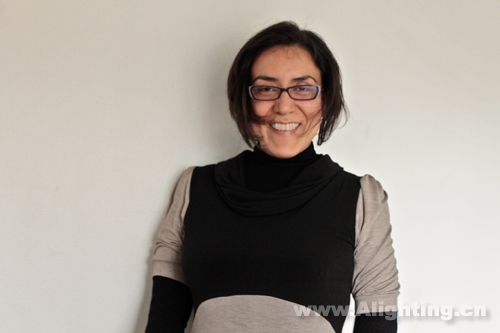
2005年到2008年期间,Paulina被任命为智利一本建筑杂志的主编,同时,她也是技术杂志《Alumundo》关于灯光设计的专栏作者。2006年,她与Luxia照明合作开展名为Noche Zero的光研究项目。从2008年开始,Paulina受聘为瑞典皇家理工学院灯光设计研究生专业的讲师。此外,她也经常给智利建筑师们授课,培训照明相关知识。
Alighting Design: How did you get into the lighting industry?
《阿拉丁·设计》:你是怎样进入照明行业的?
PV:I started working in a big office when I graduate as an Architect, and discovered there was a very specific specialization for the lighting, which is the nicest part people worried about among all the construction issues.
PV:我刚毕业是在一家大型设计公司当建筑师,当时就注意到灯光这个特殊的范畴,这也是整个工程项目中最让人赏心悦目的部分。
Two years later I design my first building (by myself!) a Cultural Center, then I realized I had no clue about lighting! So I decided to go abroad and studied to improve my architectural skills. I went to Germany for a Master course in Architectural Lighting Design in Wismar, after finish it I went to Sweden to study more about light, at KTH in Stockholm. I felt in love with light. I forgot that I was an Architect! Now I consider myself as a Lighting Designer.
两年后我独立完成了自己的第一个建筑作品——一个文化中心,并意识到我对灯光一无所知!我决定出国深造,在德国维斯马完成建筑灯光设计的硕士课程之后,又继续前往瑞典皇家理工学院学习。这时候我已经爱上了“灯光”,忘却了建筑师的身份。现在,我把自己看作是灯光设计师。
I started my own company DIAV in 2005, with one desk and my laptop. Since then it has being growing little by little. Now, to celebrate the 10 years of DIAV I came to Asia to try this challenging and vibrant context.
2005年我成立了自己的公司DIAV,从只有一张桌子一台电脑一点一点发展起来。十年后的今天,我们来到亚洲,希望能在这片充满挑战和活力的土地上继续学习和成长。
Alighting Design: Were there designers that influenced you when you started in lighting?
《阿拉丁·设计》:在你进入照明行业时,有没有哪个前辈设计师对你产生过启蒙影响?
PV: My first heroes were my teachers and mentors. I can recall Jan Ejhed and Kai Piippo from Sweden, Vesa Honkonen from Finland, Erick Selmer from Norway, Louis Claire from France, Kaoru Mende from Japan. Later, after finish my studies I can mention the inspiration and energy from Gustavo Avilés from Mexico and Martin Lupton from UK. I think all of them influence me in the way to approach the work and to make me wonder “That is the mood and ambiance in which I want to work”.
PV:有,我的老师们,像瑞典的Jan Ejhed、Kai Piippo,芬兰的Vesa Honkonen,挪威的Erick Selmer,法国的Louis Claire,日本的Kaoru Mende;也包括踏出校门之后遇到的精神导师Gustavo Avilés(墨西哥)和Martin Lupton(英国)。他们都在我的照明事业上推波助澜了一把,让我知道,这就是我想要的工作。
Alighting Design: What fascinates you the most about light?
《阿拉丁·设计》:灯光最吸引你的是什么?
PV: The power of light is to be used as a tool of space design , to create mood and emotion. It’s very technical, but the main guide is artistic. Design with light is about understanding the space to be lit and the people who will use it and feel it. Sometimes it is like working with music, which is immaterial, you just can imagine the final result.
PV:灯光最大的魅力在于营造空间氛围和情绪。事实上,充满技术性的灯光设计其实是由艺术性来引导的。设计师既要充分理解空间的结构,也要了解使用者的体验和感受,所以,灯光设计有时候就像无色无形的音乐,你只能靠想象力。
But what it really fascinates me is the design process, the creativity to deliver a design concept that will be experienced in an architectural space or in a landscape or urban place. In that process I have fun and enjoy doing it.
但真正吸引我的是设计的过程,把充满创意的构想实践在具体的建筑、景观和城市规划中,正是我的志趣所在。
Alighting Design: What is your design philosophy?
《阿拉丁·设计》:你的设计理念是什么?
PV: Design with a concept. To deliver a concept you need to brainstorm with your head, heart and guts. I also make the exercise to treat the architectural or landscape project as a person, and ask him/her: How do you wish to be lit?
PV:遵循你的设计概念,而设计概念通常源自于殚精竭虑的头脑风暴。我会把建筑或者景观项目想象成一个“人”,然后问他:“你希望怎样被照亮?”
You can solve a problem by distributing luminaires with a nice layout and calculating the lighting levels, but that is not design. The design process must start with a concept design, which will be the guidance to work with the light.
当然,漂亮的布灯和准确的照度计算能解决照明的具体问题,但那不是灯光设计。设计必须从设计概念开始,因为它将是后面工作的总指挥。
Alighting Design: What do you think of the relationship between architecture and light? How do you fuse them?
《阿拉丁·设计》:你怎样看待建筑与照明的关系?怎样将二者融合?
PV: The design process between architecture and lighting is very similar. In the way I was trained to be an architect, first you have to gather information and make an analysis of the context, climate, culture, functions, budget, timing, how people will use it, expectations and so on. Also there is a research for inspiration, find similar projects, and innovative solutions, after that comes the brainstorm for the concept or main ideas. The tools in architecture to develop those ideas are solid and concrete to work with shapes and space. But light is immaterial, so the tool is more poetic, even though the process is very similar. Light is for the people and the architecture, so you have to understand the building as good as the people who will use it.
PV:建筑和照明的设计过程非常相似。作为建筑师,首先你必须搜集大量的资料,从中分析环境、气候、文化、功能、预算、时间,以及使用者的期望等。然后你得寻求灵感,分析相似的项目,寻找革命性的解决方案,之后就是关于整个设计概念的头脑风暴。尽管过程相似,但不同的是,建筑需要跟固态的有形的建筑材料打交道,而光是无形的,充满诗意的。灯光是为人和建筑服务的,作为灯光设计师,必须把自己放在使用者的位置上,更好地解读建筑。
凡注明为其它来源的信息,均转载自其它媒体,转载目的在于传递更多信息,并不代表本网赞同其观点及对其真实性负责。
用户名: 密码:

